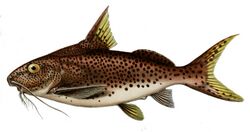Biology:Synodontis multipunctatus
| Cuckoo catfish | |
|---|---|

| |
| Scientific classification | |
| Domain: | Eukaryota |
| Kingdom: | Animalia |
| Phylum: | Chordata |
| Class: | Actinopterygii |
| Order: | Siluriformes |
| Family: | Mochokidae |
| Genus: | Synodontis |
| Species: | S. multipunctatus
|
| Binomial name | |
| Synodontis multipunctatus Boulenger, 1898
| |
Synodontis multipunctatus, also known as the cuckoo catfish, cuckoo squeaker, or multipunk, is a small catfish from Lake Tanganyika, one of the lakes in the Great Rift Valley system in Africa. It is a brood parasite upon mouthbrooding cichlids. This species grows to a length of 27.5 centimetres (10.8 in) TL. This species is a minor component of local commercial fisheries.[2]
General

Synodontis multipunctatus is one of a number of species of upside-down catfish in Lake Tanganyika, which is more famous for its cichlids. It gathers in large schools at depths of about 40 metres (130 ft) in the lake.
S. multipunctatus is notable for its breeding behaviour - it is a brood parasite, similar to the cuckoo from which it takes its common name. Lake Tanganyika is home to a number of mouthbrooding cichlids, which care for their eggs and young by carrying them in their mouth. S. multipunctatus uses these, particularly Ctenochromis horei and Simochromis babaulti, as unwitting caretakers for their children.
The smell of spawning cichlids excites S. multipunctatus into spawning, and as the cichlids lay their eggs the catfish will quickly slip in and eat the eggs before they can be collected by the mother. While doing so they also release and fertilise their own eggs. The female cichlid will hastily attempt to scoop up her eggs and, in doing so, will also collect eggs from S. multipunctatus. These eggs will then hatch inside the unwilling adoptive mother's mouth, and proceed to eat the cichlid eggs present before being released by the cichlid. This technique removes the burden of parental care from the S. multipunctatus, and allows them to breed again sooner.
In the aquarium
Synodontis multipunctatus are a popular addition to cichlid aquariums. They grow to about 15 centimetres (5.9 in), and can be bred in captivity provided suitable hosts are present. Some aquarists have had success with host cichlids from Lake Malawi and Lake Victoria as well as those from Lake Tanganyika.[3] They can be very aggressive and territorial towards other Synodontis species, they should be kept in groups over 3 to avoid competition between two, and proper cover and cave-like structures should be provided. They seem to be active in the day as much as the night and can prove quite lively. If kept in larger groups territorial issues are less likely.
See also
- List of freshwater aquarium fish species
- Synodontis multipunctatus was featured in the "Interesting Fauna" section of Episode 292 of the 'Geologic Podcast'[4] by George Hrab.
References
- ↑ Ntakimazi, G. (2006). "Synodontis multipunctatus". IUCN Red List of Threatened Species 2006: e.T60815A12411850. doi:10.2305/IUCN.UK.2006.RLTS.T60815A12411850.en. https://www.iucnredlist.org/species/60815/12411850. Retrieved 19 November 2021.
- ↑ Froese, Rainer and Pauly, Daniel, eds. (2014). "Synodontis multipunctatus" in FishBase. May 2014 version.
- ↑ "Maenam Shop" (in th). facebook. July 14, 2016. https://www.facebook.com/175457175874882/photos/a.495547867199143.1073741841.175457175874882/1057160994371158/?type=3&theater.
- ↑ "Geologic Podcast - Episode 292". http://geologicpodcast.com/the-geologic-podcast-episode-291-1.
Further reading
- Tanganyika cichlids in their natural habitat, Ad Konigs, Cichlid Press, 1998
- Lake Tanganyika cichlids: A complete pet owners manual, Mark P. Smith, Barron's Educational Services, 1998
- Schraml, Erwin (August 2003). "Fiederbartwelse aus dem Tanganjikasee" (in de). DATZ 8: 60–7. ISSN 1616-3222.
- Blažek, Radim; Polačik, Matej; Smith, Carl; Honza, Marcel; Meyer, Axel; Reichard, Martin (2018). "Success of cuckoo catfish brood parasitism reflects coevolutionary history and individual experience of their cichlid hosts". Science Advances 4 (5): eaar4380. doi:10.1126/sciadv.aar4380. PMID 29732407. Bibcode: 2018SciA....4.4380B.
- "Brood parasitism in fish". ScienceDaily (Press release). May 9, 2018.
External links
Wikidata ☰ Q606358 entry
 |


